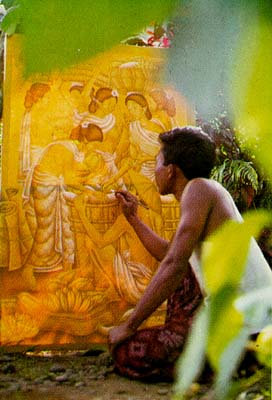
Ubud Village
|
|
The trip
to Ubud is a
time change: from stone dwellings of antiquity to a current center of
fine arts noted for its painters. On the threshold of Ubud is the
village of Peliatan with an especially active dance troupe and gamelan
orchestra. These famous musicians have represented Indonesia abroad in
Europe and the United States. The village puri continues the tradition
of fine performing with private dance lessons for aspirants from the
age of five. it's delightful to watch a Legong instructor glide through
the motions of the dance trailed by four little girls, their feet
weaving patterns over the courtyard and their faces set in
concentration to the essential rhythm of the drum.
|

|
|
A quieter
rhythm guides
the daily life of Ubud. Each morning, farmers set their fighting cocks
along the roadside to bask in the sun. Covarrubias says they do this so
the cocks will be amused watching the passers-by: sturdy women
suspending hemispheres of pots to be sold at market, farmers bearing
sheaves of rice, and nowadays passing automobiles. It's nice to join
them and stroll through the plentiful shops that line the avenue
opposite the old puri in the town's center.
|
|
Ubud is
excellent for
shopping. Galleries display contemporary styles by old masters of
thirty years experience and young boys who have developed a manner of
their own-the "Young Artists" style. Many shops have studios at the
back where you may watch painters at work.
|
|
For
decades the serene
beauty of this village has lured celebrities and artists from all over
the world, some of whom stayed to build their homes here. Down the road
at Campuan, the junction of two rivers that flow through Ubud, are the
former residences of Waiter Spies and Rudolf Bonnet, artists who lived
here during the thirties. With the support of Cokorda Gede Agung of
Ubud, these two painters founded the Pitha Maha, a society which
encouraged the young artists of the area, criticized them, provided
them with materials and encouragement, and patronized their work.
Spies' own paintings inspired the Balinese artists to abandon the rigid
forms of the traditional style and adopt such European techniques as
perspective. (Spies died during World War lI)
|
|
Since the
turn of the
century the art of North Bali had come under European influence. The
modern styles of Ubud and Batuan drew their inspiration from the scenes
of everyday life about them, besides from the classic stories of Old
Javanese literature. Many Balinese painters associated with Pitha Maha
are internationally renowned, like the late I Gusti Nyoman Lempad, and
others remain to this day among the island's most outstanding artists:
lda Bagus, Made Poleng and several others, each working in his own
style. An outstanding woodcarver was I Tjokot from the village of Jati,
1.5 kilometers north of Ubud. Mas and Nyuhkuning are other early
woodcarving centers still active.
|
|
At the
present time,
Dutch-born Han Snel and the American Antonio Blanco are the long
resident foreign painters. They have galleries in their homes where
their works may be seen. Dutch-born Arie Smit encouraged young artists
to create bold, simplistic paintings from which arose the "Young
Artists" style with its bright colors. The patronage of the arts
continues, with friends and collectors intermittently sponsoring
exhibitions abroad.
|
|
The Museum
Puri Lukisan
(Palace of Fine Arts), also called the Museum Ratna Wartha, was begun
in 1954 and opened two years later as a permanent collection of modern
Balinese art. Beautifully situated above a garden, the museum displays
sculpture and paintings in chronological order, giving a clear view of
the modern movements in Bali's art centers. In the early seventies two
new buildings were added, one being used for exhibitions. Bonnet
returned to Bali in 1973 to help expand the permanent collection.
|
|
Ubud is
the only
important tourist center in Bali outside the Denpasar-Sanur-Kuta area.
There are several hotels, and recently in 1975 electricity came. Many
tourists like to make Ubud their home while in Bali and travel out from
there. Besides the main trips, there are many roads and places near at
hand that are enjoyable to visit. The terraced fields and waterfalls in
nearby gorges invite one to leave transport behind and set off on foot.
Any direction is fine. The best-known walk is to the monkey forest,
just south of Ubud, where a troop with a fine-looking king inhabits the
surviving patch of jungle. A great Banyan tree straddles the nearby
gorge on the path down. The Pura Dalem on the edge if the forest has
exceptionally fine statues of Rangda gorging herself on young children.
The road south through Padangtegal leads to Pengosekan, a village of
painters since the thirties. It is well known for the varied and
individual style of its artists and was visited by Queen Elizabeth II
in 1974.
|
|
Cross over
the
suspension bridge at Campuan, and turn left several hundred meters
beyond, for the path to Penestanan, main village of the "Young
Artists". On trips further afield on the back roads, a motorbike is
best. From Ubud, two roads, besides the usual one via Tampaksiring,
lead to Kintamani. One road goes through Payangan, famous for its
lichens which grow nowhere else in Bali. The second road is surfaced as
far as Tegaialang. Jati, where I Tjokot lived, is just off the latter
road beyond Tegaialang. There are several art shops along the road. Up
nearer the crater, be prepared to encounter thick volcanic sands left
behind when Gunung Agung erupted in 1963. Ubud serves well both the
traveler who wants to get about and those who prefer a quiet relaxing
stay.
|
Copyright
2001-2015, K&D Bali Designs. All rights reserved.
|